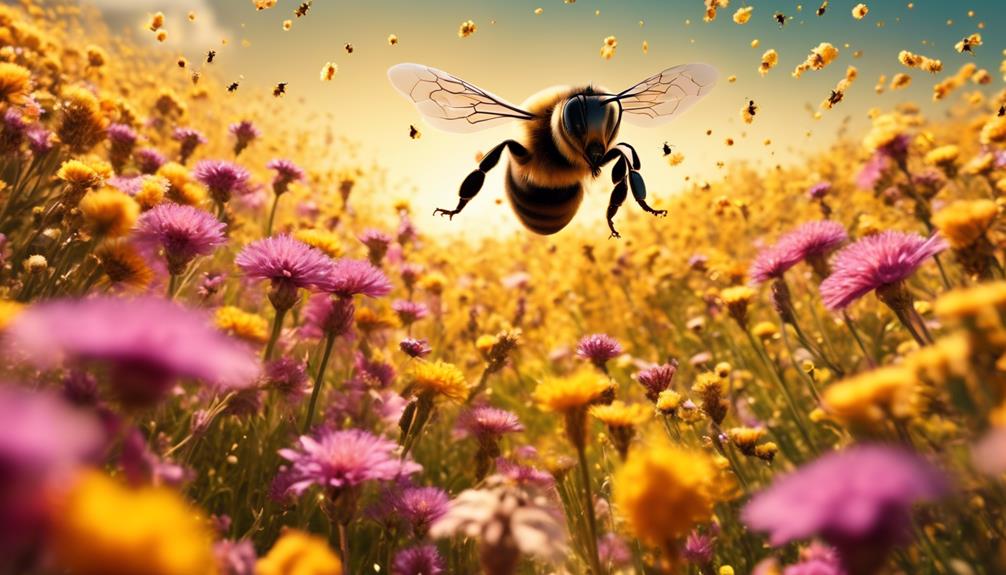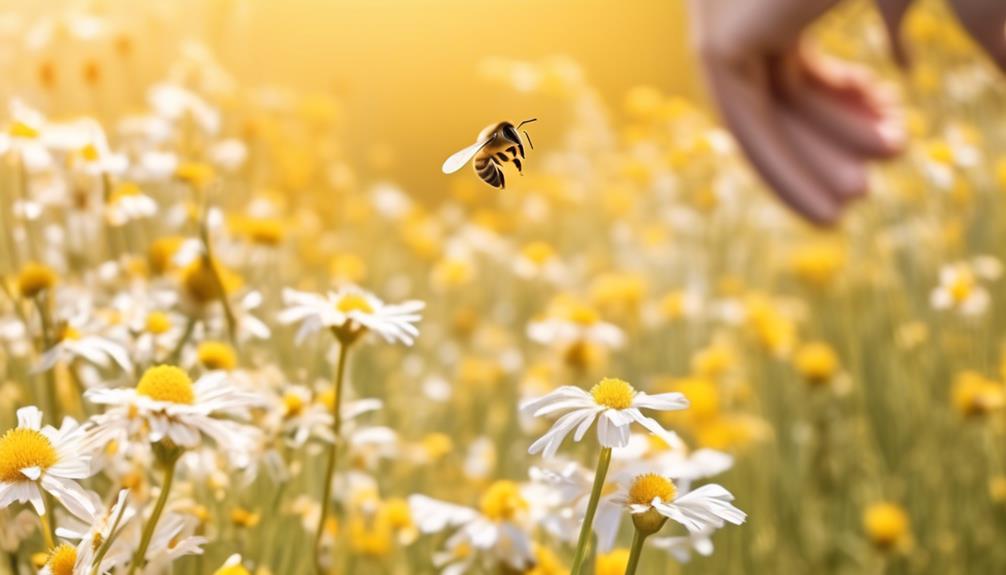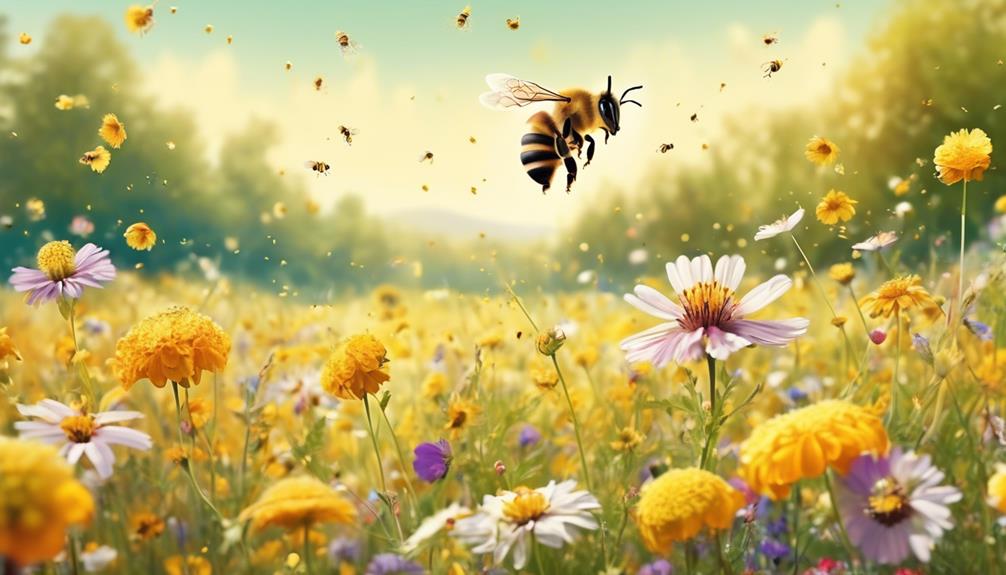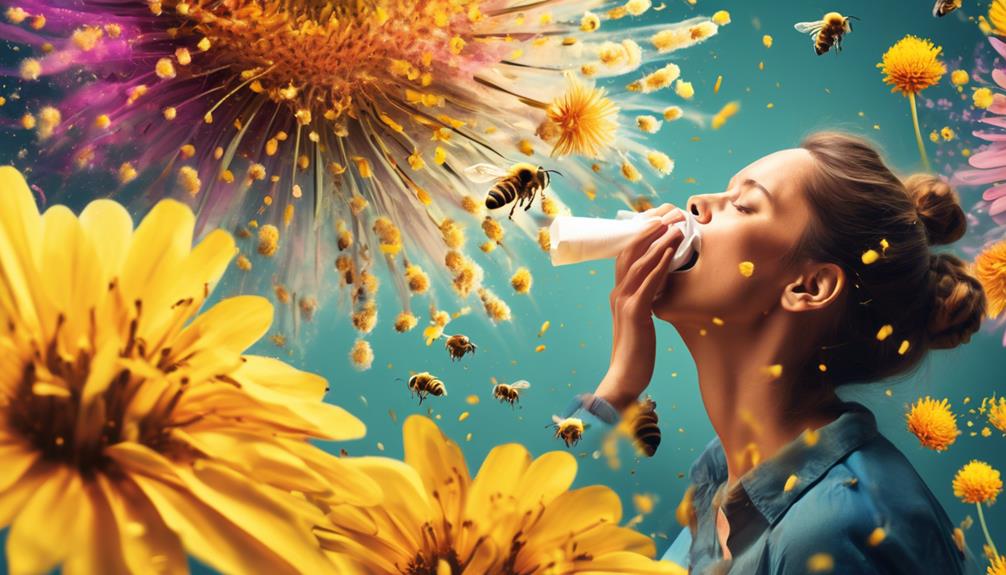Uncover the truth about bees and their role in hay fever, challenging common myths and exploring the real culprits behind your allergy symptoms.

Do Bees Cause Hay Fever?
You've probably heard the age-old myth that bees are the sworn enemies of hay fever sufferers, single-handedly responsible for every sneeze, sniffle, and watery eye during allergy season. In reality, bees serve as crucial pollinators in our ecosystem, yet they've somehow been vilified in the realm of allergies.
It's crucial to clear up the confusion and better understand the role of bees and their relationship to hay fever. But if bees aren't the culprits, then what or who is to blame for your hay fever? Let's explore this further to unravel the truth behind your symptoms.
Key Takeaways
- Hay fever is an allergic reaction to airborne substances, particularly pollens.
- Bees are not responsible for causing hay fever symptoms.
- Wind-pollinated plants release small, airborne pollen particles that trigger hay fever.
- Understanding the true causes of hay fever can help individuals manage their symptoms effectively.
Understanding Hay Fever

While you may think of hay fever as just a seasonal nuisance, it's actually an allergic reaction to airborne substances, particularly pollens, that affects your nose, throat, and eyes. When you inhale these allergens, your immune system overreacts and releases chemicals like histamine into your bloodstream. This results in the common symptoms you associate with hay fever – itchy eyes, a runny nose, sneezing, and congestion.
Within the broader classification of hay fever, or allergic rhinitis as it's scientifically known, there are two primary types: seasonal and perennial. Seasonal allergic rhinitis, as the name suggests, occurs during specific seasons when certain plants release pollen. Perennial allergic rhinitis, on the other hand, happens year-round and is triggered by indoor allergens like dust mites, pet dander, and mold.
It's crucial to understand that hay fever isn't merely an inconvenience. If left untreated, it can lead to other health issues like sinusitis and sleep disorders. So, while bees and their pollination practices may seem like the culprits, they're merely part of a larger, more complex allergic reaction.
Common Triggers of Hay Fever

You're likely to encounter a variety of allergens that can trigger your hay fever symptoms, including both outdoor and indoor substances. Outdoors, the most common triggers are typically plant pollens. This includes tree pollens, which are most prevalent in the spring, grass pollens that peak in the late spring and early summer, and weed pollens that are most common in late summer and fall.
Indoors, dust mites, mold spores, and pet dander often cause hay fever symptoms. Dust mites live in household dust and are most common in humid climates. Mold spores can be found in damp areas, such as bathrooms and basements. Pet dander, which includes tiny flakes of skin and dried saliva, can trigger symptoms in those allergic to animals.
It's important to remember that these are just common triggers. Everyone's immune system responds differently, and what causes hay fever in one person may not cause it in another. Identifying your specific triggers can help you manage your symptoms and avoid exposure to allergens whenever possible. Your doctor can provide a detailed list of potential allergens and offer tests to identify your personal triggers.
Bees: Pollinators, Not Allergens

Despite the common association of bees with pollen, these insects aren't actually allergenic triggers, but vital pollinators. You might be surprised to learn that the pollen bees carry doesn't cause your hay fever symptoms. This is because bees collect large, sticky pollen grains incapable of becoming airborne and getting into your nasal passages, which is necessary for an allergic reaction to occur.
Instead, it's the wind-driven pollen from trees, grasses, and weeds that's to blame for your watery eyes and sneezing. These plants produce small, light, and dry pollen particles that can be easily inhaled, triggering your unpleasant symptoms.
Bees, on the other hand, are crucial for our ecosystem. They help plants reproduce by transferring pollen from the male parts of a flower to the female parts. This process, known as pollination, results in the production of fruits and seeds. Without bees, many of our favorite foods would become much less common and more expensive.
The Misconception Around Bees and Hay Fever

Contrary to popular belief, it's not the bees buzzing around your garden contributing to your hay fever, but rather the wind-pollinated plants releasing small, airborne pollen particles. Bees, in fact, carry heavy, sticky pollen that clings to their bodies and rarely becomes airborne. This type of pollen, which is often from brightly coloured, fragrant flowers, isn't the type that typically triggers hay fever symptoms.
So why the misconception? It's likely due to the timing. Hay fever usually hits in the spring and summer – just when bees are most active. Yet, it's the wind-borne pollen from trees, grasses, and weeds, not the bee-transported pollen, causing your sneezing, runny nose, and itchy eyes.
The fact is, bees are more of a solution than a problem when it comes to hay fever. By transferring pollen from flower to flower, they're helping to reduce the amount of pollen that becomes airborne. So, next time you spot a bee in your garden, don't blame it for your hay fever woes. Instead, appreciate its role in alleviating your symptoms.
Tips to Prevent Hay Fever

To effectively manage hay fever, understanding and implementing preventive measures is key. You should begin by reducing your exposure to allergens. This means, for instance, keeping windows closed during pollen-heavy times of the day, typically early morning and late evening.
Wearing sunglasses can protect your eyes from airborne allergens. You should also shower and change into fresh clothes after spending significant time outdoors, as pollen can cling to fabric and hair. Furthermore, it's recommended to keep indoor air clean. Consider using high-efficiency particulate air (HEPA) filters in ventilation systems and vacuum cleaners.
Over-the-counter antihistamines can be beneficial, but it's best to consult with a healthcare provider for a tailored, effective treatment plan. Immunotherapy might be a viable option if your symptoms are severe or year-round. This involves regular injections or tablets that help your body get used to allergens, reducing the severity of your allergic reactions over time.
Lastly, maintaining a healthy lifestyle, including a balanced diet and regular exercise, can boost your immune system and limit the impact of hay fever. While these preventative measures won't eliminate hay fever completely, they can significantly reduce your symptoms and improve your quality of life.
Frequently Asked Questions
What Is the Lifespan of a Typical Bee?
You're curious about the lifespan of a typical bee, aren't you? Well, it varies greatly depending on the type of bee.
A worker honeybee, for instance, lives for about six weeks during the summer, while queens can survive up to five years.
Male bees or drones live only until they mate.
Bumblebees and solitary bees have similar lifespans.
Does Consuming Honey Help to Build Immunity Against Hay Fever?
No, bees don't cause hay fever. It's pollen from trees, grasses, and weeds that triggers hay fever, not bees.
However, there's a belief that eating local honey can help build immunity to pollen. Although it sounds plausible, there's no scientific evidence to back this up.
It's best to consult with your healthcare provider for effective treatment options. Remember, honey shouldn't be given to children under one year of age.
What Are Some Other Common Misconceptions About Bees?
You might think bees are solely responsible for pollination or that all bees produce honey. Not true. There are over 20,000 bee species, and not all of them are pollinators. Only a small percentage produce honey.
Another misconception is that bees are aggressive. Most bees won't sting unless threatened.
Understanding these misconceptions can help you appreciate the diverse roles bees play in our ecosystem.
Are There Other Insects That Contribute to Spreading Pollen?
Yes, there are indeed other insects that partake in spreading pollen. Butterflies, moths, beetles, and even certain types of flies can act as pollinators. It's their interaction with flowers, much like bees, that allows for the transfer of pollen.
They're attracted to the nectar and in the process, they inadvertently gather pollen on their bodies. When they move to the next flower, some pollen rubs off, effectively pollinating the new flower.
Can Changes in Weather Patterns Affect the Severity of Hay Fever?
Yes, changes in weather patterns can significantly affect the severity of your hay fever. Warm, windy days are likely to increase pollen count, aggravating your symptoms.
Conversely, rainy days can cleanse the air of pollens, providing you some relief.
Furthermore, climate change may increase pollen production in plants, potentially heightening hay fever severity in the long run.
Therefore, monitoring weather forecasts can be a crucial part of managing your hay fever.
Conclusion
In conclusion, you've got it wrong if you're blaming bees for your hay fever. They're pollinators, not allergens. Hay fever is typically triggered by airborne pollen, dust mites, molds, or pet dander.
Bees help in pollination, but they don't spread allergens that cause hay fever. So, don't point your finger at them. Instead, focus on practical prevention tips like wearing sunglasses, avoiding outdoor activities during high pollen counts, and keeping your home allergen-free.


